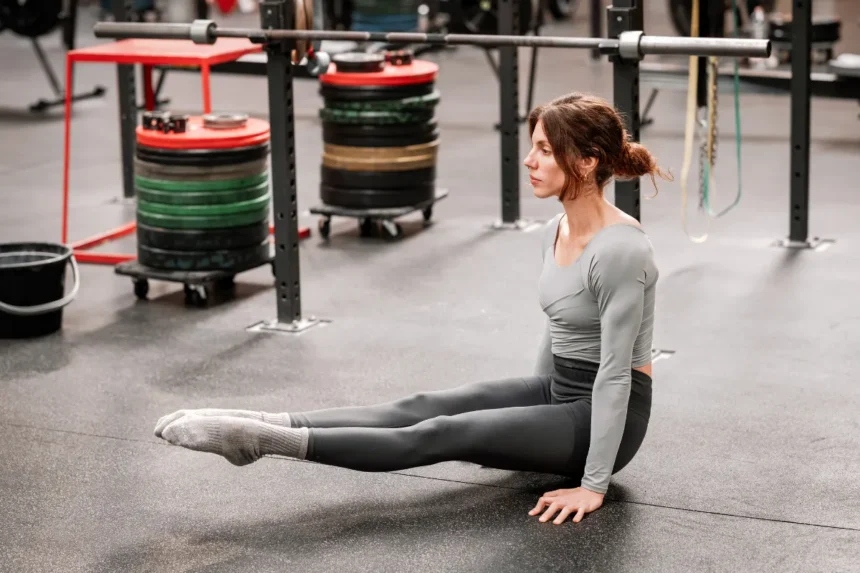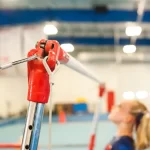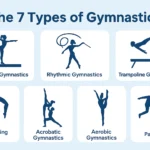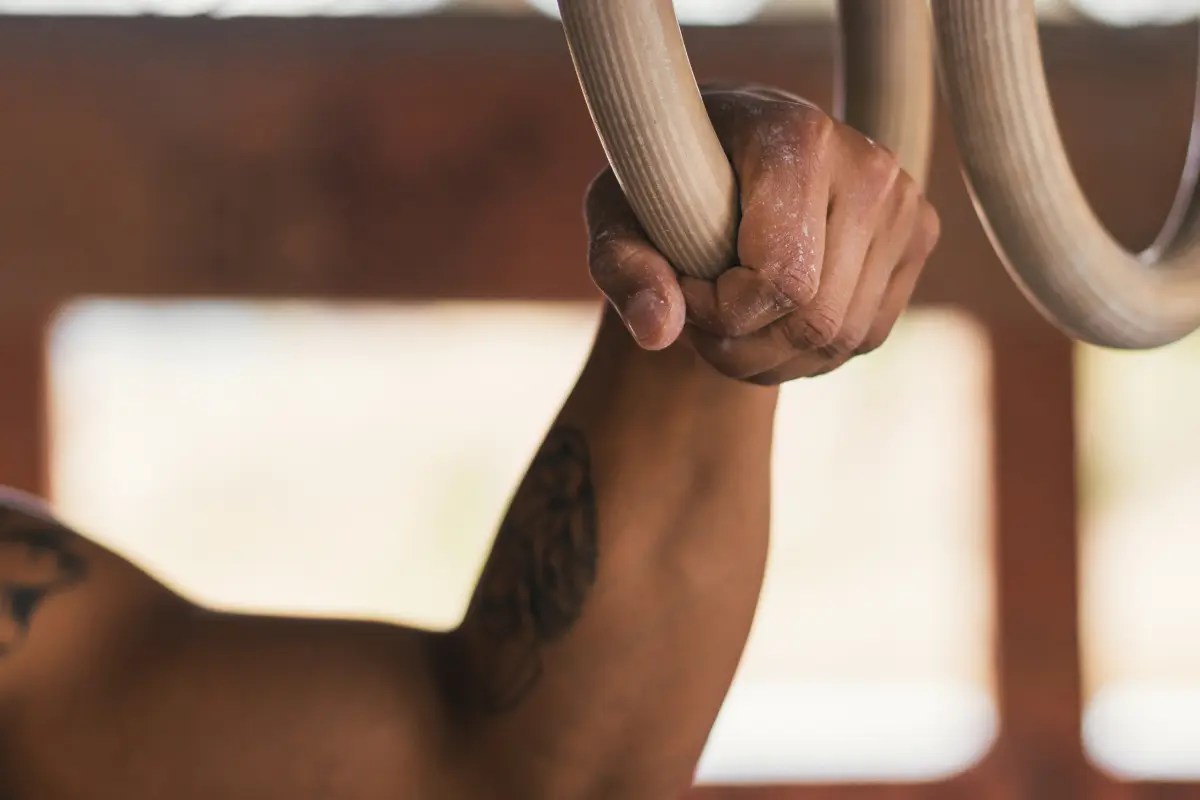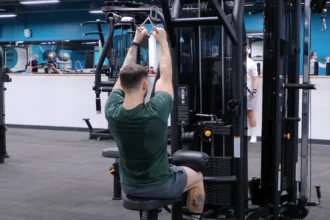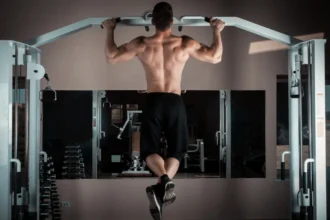Gymnastics conditioning is about more than just getting stronger. It’s about learning how to control your body, maintain tension through complex shapes, and move efficiently from head to toe.
- 1. Banded Overhead Pike
- 2. Side-to-Side Hip Mobility Drill
- 3. Mini-Band Core Control (Floor-Based)
- 4. Leg Roller Squeeze (Compression Core Exercise)
- 5. Dynamic Pike Roll-Ups
- 6. Back Extension Roll to Hand Support
- 7. Windmill (Bar or Floor Version)
- 8. Pike Leg Lifts (Legless Progression)
- 9. Full-Body Awareness & Integration
- How to Use This Routine
This full-body routine uses nine gymnastics-style conditioning exercises that target mobility, core strength, compression, shoulder stability, and hip control. Some movements are advanced, but every exercise includes options so you can adjust based on your level.
You can perform this routine as:
- A standalone conditioning workout
- A warm-up or supplemental session
- A home workout with minimal equipment
Aim for 1–3 rounds, resting as needed between exercises.
1. Banded Overhead Pike
Primary focus: Shoulder mobility, hamstring flexibility, spinal control
Gymnastics benefit: Improves overhead positions for handstands, giants, and tumbling takeoffs
This exercise begins the workout by opening the shoulders while gently loading the posterior chain. Holding a resistance band, stick, or even a towel overhead, hinge forward into a pike position.
The coaching goal is length, not depth. You want to feel your shoulders stay active while your hips fold cleanly.
Key coaching cues:
- Press the band upward to keep shoulders engaged
- Hinge from the hips, not the lower back
- Keep your chest long rather than collapsing forward
If your back bends slightly, that’s okay. Over time, improved flexibility will allow a flatter shape without forcing it.
Regression: Reduce range of motion
Progression: Pause at the bottom for 2–3 seconds or add slow tempo
2. Side-to-Side Hip Mobility Drill
Primary focus: Hip internal/external rotation, knee tracking, ankle mobility
Gymnastics benefit: Supports landings, leaps, turns, and beam stability
This is an advanced mobility drill that challenges hip control while maintaining knee alignment. The movement flows side to side, encouraging the hips to open while the knees track safely over the toes.
This drill often feels awkward at first—and that’s normal. It requires coordination, balance, and patience.
Key coaching cues:
- Keep your heel grounded as long as possible
- Allow the hips to open gradually
- Avoid collapsing the knee inward
Regression:
Lower as far as comfortable, use hands for support, drop one knee at a time, then rotate back up.
Progression:
Increase depth, slow the transition, or remove hand support completely.
3. Mini-Band Core Control (Floor-Based)
Primary focus: Deep core engagement, pelvic control
Gymnastics benefit: Improves hollow positions, dance elements, and body tension
With a mini band around the feet (optional), this floor exercise reinforces the idea of cinching the waist, rather than just bracing the abs.
This is subtle but critical in gymnastics. The goal is inward tension, not stiffness.
Key coaching cues:
- Draw the ribs down toward the hips
- Keep hips level and quiet
- Control the movement rather than swinging
Watching yourself in a mirror or camera can help catch alignment issues early.
Regression: Remove the band
Progression: Slow tempo or increase hold time
4. Leg Roller Squeeze (Compression Core Exercise)
Primary focus: Inner thighs, lower abs, compression strength
Gymnastics benefit: Essential for leg lifts, pike shapes, bars and trampoline skills
Lying on your back with a ball, roller, or water bottle between your feet, this exercise emphasizes active squeezing, not passive holding.
This teaches the legs and core to work together, something many athletes struggle with.
Key coaching cues:
- Squeeze inward continuously
- Keep lower back controlled against the floor
- Move with intention, not speed
If your lower back feels strained, place your hands under your hips. Advanced athletes can extend the arms overhead to increase load.
Progression option:
Slow the movement to 4 seconds up, 4 seconds down for rehab or control phases.
5. Dynamic Pike Roll-Ups
Primary focus: Core strength, hamstring flexibility, spinal articulation
Gymnastics benefit: Improves pike compression for bars, beam jumps, and dance elements
This exercise combines speed and control, fast up, slow down. The upward phase encourages explosive compression, while the descent builds control and awareness.
Key coaching cues:
- Snap up with intent
- Lower down vertebra by vertebra
- Grab where flexibility allows, don’t force range
Regression: Bend knees slightly or grab lower on legs
Progression: Add pauses at the top
6. Back Extension Roll to Hand Support
Primary focus: Shoulder power, extension mechanics, coordination
Gymnastics benefit: Transfers directly to handstand entries, backward tumbling, and bar skills
This is one of the most technical exercises in the routine. The key skill is learning to push aggressively through the arms to create lift.
Key coaching cues:
- Slam the hands into the floor
- Open the shoulders fully
- Think “pop,” not “press”
Regression drill:
From pike, roll back into candlestick and practice slamming the hands down without standing up.
Regression option: Perform from knees
Progression: Increase speed and height
7. Windmill (Bar or Floor Version)
Primary focus: Obliques, compression, rotational control
Gymnastics benefit: Supports bar circles, twisting skills, and core stability
The windmill teaches athletes to move the lower body independently while stabilizing the upper body.
On the bar, it’s advanced and demanding. On the floor, it becomes an excellent progression tool.
Key coaching cues:
- Keep shoulders quiet and grounded
- Drive movement through the obliques
- Maintain compression throughout
Regression: Floor version with or without a ball
Progression: Increase range or perform on bar
8. Pike Leg Lifts (Legless Progression)
Primary focus: Hip flexors, lower abs, compression strength
Gymnastics benefit: Critical for legless climbs, bar work, and trampoline skills
This exercise exposes weaknesses in both flexibility and core strength.
Key coaching cues:
- Lift through the core first
- Stay within flexibility limits
- Avoid snapping into position
One major correction: don’t look down. Keeping your gaze slightly forward or up dramatically improves leg lift efficiency.
Regression: Floor-based pike lifts
Progression: Increase reps or hold at top
9. Full-Body Awareness & Integration
While the final exercise physically challenges the core, its deeper purpose is integration, bringing together everything trained before it.
This is where fatigue meets control.
Key coaching cues:
- Maintain form even when tired
- Breathe through effort
- Finish strong without rushing
This final movement reinforces that gymnastics conditioning is about quality under fatigue, not just surviving the workout.
How to Use This Routine
- Warm-up: 1 round, controlled tempo
- Conditioning block: 2–3 rounds
- Rehab or control phase: Slow tempo, fewer reps
Rest briefly between exercises as needed, but aim to maintain flow.
